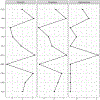Examining a Syndemics Network Among Young Latino Men Who Have Sex with Men
- PMID: 31820288
- PMCID: PMC7257435
- DOI: 10.1007/s12529-019-09831-1
Examining a Syndemics Network Among Young Latino Men Who Have Sex with Men
Abstract
Background: Although studies consistently find that syndemic indicators are additively associated with increased HIV/STI risk behavior (e.g., condomless anal sex; CAS) among men who have sex with men (MSM), information is lacking about how syndemic indicators are associated with each other. Young Latino MSM are one of the most at-risk groups for acquiring HIV in the U.S. Understanding the associations of syndemic indicators with each other and with CAS may improve understanding of how to enhance sexual and behavioral health in this population.
Method: Network analysis using the graphical LASSO (glasso) algorithm was employed to explore associations between CAS and syndemic indicators among 139 young Latino MSM. Structural and psychosocial syndemic indicators were assessed via self-report. CAS was defined as the number of partners in the past 3 months with whom one engaged in CAS.
Results: Results of the network analysis suggested the variables with the highest centrality were unstable housing, prison history, childhood sexual abuse, and CAS. Specific significant associations included links between CAS and alcohol use (b = 0.40), childhood sexual abuse and unstable housing (b = - 0.75), alcohol use and childhood sexual abuse (b = 0.40), and substance use and intimate partner violence (b = 0.43).
Conclusion: This pattern of interconnectedness demonstrates the potential for network analysis to examine nuanced interrelationships of syndemic indicators. The specific associations in this sample raise the question whether a primary focus of interventions should address the more central syndemic indicators for this population, such as alcohol use and unstable housing, and whether this would, via downstream effects, affect other aspects of behavioral health in this population.
Keywords: HIV; Latino; Men who have sex with men; Network analysis; Syndemic indicators.
Conflict of interest statement
Conflict of Interest
The authors declare that they have no conflict of interest.
Figures


Similar articles
-
Syndemic Health Disparities and Sexually Transmitted Infection Burden Among Black Men Who Have Sex with Men Engaged in Sex Work in the U.S.Arch Sex Behav. 2021 May;50(4):1627-1640. doi: 10.1007/s10508-020-01828-2. Epub 2020 Nov 6. Arch Sex Behav. 2021. PMID: 33159237 Free PMC article.
-
Connecting the dots: a comparison of network analysis and exploratory factor analysis to examine psychosocial syndemic indicators among HIV-negative sexual minority men.J Behav Med. 2020 Dec;43(6):1026-1040. doi: 10.1007/s10865-020-00148-z. Epub 2020 May 2. J Behav Med. 2020. PMID: 32361793 Free PMC article.
-
Longitudinal Analysis of Syndemic Psychosocial Problems Predicting HIV Risk Behavior Among a Multicity Prospective Cohort of Sexually Active Young Transgender Women in the United States.J Acquir Immune Defic Syndr. 2019 Jun 1;81(2):184-192. doi: 10.1097/QAI.0000000000002009. J Acquir Immune Defic Syndr. 2019. PMID: 30839380 Free PMC article.
-
Syndemic theory, structural violence and HIV among African-Americans.Curr Opin HIV AIDS. 2020 Jul;15(4):250-255. doi: 10.1097/COH.0000000000000634. Curr Opin HIV AIDS. 2020. PMID: 32487818 Review.
-
Integrative Review of Methods From Youth Risk Behavior Survey Secondary Data Analyses Examining HIV Syndemic Factors Among Adolescent Gay and Bisexual Men.Nurs Res. 2023 Mar-Apr 01;72(2):141-149. doi: 10.1097/NNR.0000000000000632. Epub 2022 Dec 9. Nurs Res. 2023. PMID: 36729784
Cited by
-
Syndemic Conditions, Sexual Risk Behavior, and HIV Infection Among Men Who Have Sex with Men in Taiwan.AIDS Behav. 2021 Nov;25(11):3503-3518. doi: 10.1007/s10461-021-03269-x. Epub 2021 May 5. AIDS Behav. 2021. PMID: 33950337
-
A network analysis of positive psychosocial factors and indication of suboptimal HIV care outcomes among Black women living with HIV.AIDS Care. 2024 Oct;36(10):1410-1423. doi: 10.1080/09540121.2024.2372714. Epub 2024 Jul 3. AIDS Care. 2024. PMID: 38958126
-
Peer ambassador stories: formative qualitative research to enhance the reach of PrEP, HIV testing, and behavioral health treatments to LMSM in South Florida.AIDS Care. 2024 Apr;36(4):569-579. doi: 10.1080/09540121.2023.2287736. Epub 2023 Dec 29. AIDS Care. 2024. PMID: 38157344 Free PMC article.
-
Inequitable access to PrEP among gay, bisexual, and other men who have sex with men in Canada: A network analysis of social indicators.SSM Popul Health. 2025 Mar 10;30:101771. doi: 10.1016/j.ssmph.2025.101771. eCollection 2025 Jun. SSM Popul Health. 2025. PMID: 40177026 Free PMC article.
-
A systematic comparison of additive and interaction approaches to modeling the effects of syndemic problems on HIV outcomes in South Africa.J Behav Med. 2024 Dec;47(6):1028-1039. doi: 10.1007/s10865-024-00517-y. Epub 2024 Sep 21. J Behav Med. 2024. PMID: 39306630
References
-
- Singer M AIDS and the health crisis of the U.S. urban poor; the perspective of critical medical anthropology. Soc Sci Med. 1994;39:931–48. - PubMed
-
- Ferlatte O, Hottes TS, Trussler T, Marchand R. Evidence of a syndemic among young Canadian gay and bisexual men: uncovering the associations between anti-gay experiences, psychosocial issues, and HIV risk. AIDS Behav. 2014;18:1256–63. - PubMed
-
- Mimiaga MJ, Biello KB, Robertson AM, Oldenburg CE, Rosenberger JG, O’Cleirigh C, et al. High prevalence of multiple syndemic conditions associated with sexual risk behavior and HIV infection among a large sample of Spanish- and Portuguese-speaking men who have sex with men in Latin America. Arch Sex Behav. 2015;44:1869–78. - PubMed
MeSH terms
Grants and funding
LinkOut - more resources
Full Text Sources
Medical
Miscellaneous

